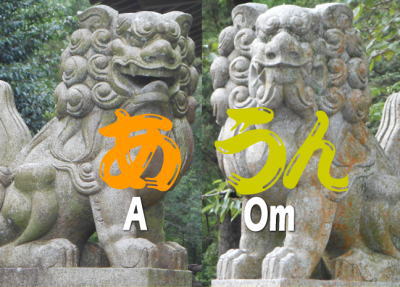Differences Between English and Japanese
The Ambiguity of the Japanese Language
 Are They Mind Readers? Are They Mind Readers?
Nowadays, things are changing in Japan both at work or home, but some old folks may be familiar and nostalgic with the following scenes:
At Work
Boss: (Suddenly he remembers something) Hey, Suzuki-kun, what happened to that matter?
Suzuki: Don’t worry, Buchō. I’m on it.
Boss: Good. Do it accordingly.
At Home
Husband: Hey.
Wife: Here you are! (Brings him a newspaper)
Husband: (After a while) Hey.
Wife: Here you are! (Serves him a cup of tea)
Those are typical cases called A-Om Breathing (A-Un no Kokyū), the most traditionally valued form of communication in Japan. But, as I said, very few appreciate that kind of don’t-say-it-all interaction anymore, and most subordinates would ask, “What matter, sir?” or bosses with such a low direction skill may have long gone out of office. Couples, too, are not something they used to be, and husbands who would need baby-like care can't become husbands in the first place these days.
However, the language won’t change so fast. Permeated by the people’s preference for “not saying directly”, the Japanese language is a catalogue of various hazy, ambiguous expressions, which probably have puzzled many non-Japanese people living in Japan.
 Weird Smiles And Enigmatic Phrases Weird Smiles And Enigmatic Phrases
It’s been a while since someone started to say Japanese people’s smiles are enigmatic and baffling. As a native Japanese, I won’t complain if da Vinci’s Mona Lisa gets love for that mysterious smile and Japanese, yuck for the same.
Anyway, I think their smiles, too, reflect Japanese love for ambiguity, and it’s pretty natural considering that facial expressions are another form of representation of yourself, just like words and phrases. But, more importantly, most of those smiles are not malign — let’s say they are in their semi-shy, neutral emotional state.
Now I can roughly categorize Japanese vague verbal attitudes as follows:
- Indirect Reference
- Airbrushing
- Neutralization
1. Indirect Reference
The first example in the previous section using the demonstrative “that” falls under this category. The second interaction between a husband and wife may well be an example of this category, too, because the interjection “hey” triggers a reference to specific things.
Another outstanding example of this type is how people address others. Consider the following conversation:
President (CEO): Who told you to do this?
Employee: Shachō told me, sir.
President: No, I didn’t tell you such a thing!
Employee: Yes, I remember. Shachō did last week.
Do you see the employee repeatedly uses the term “Shachō”, which is the Japanese title for President or CEO, instead of the word “you”, the second-person pronoun? But, that’s quite natural in a Japanese conversation since using a second-person pronoun to address the other party is not customary. Please see my column article: Is Using “You” Rude in Japan? for details.
2. Airbrushing
Japanese writers and speakers often add airbrushing to what they say. For example, when they say, “It is said that (their idea)”, “I would think that (their idea)” or another less-confident-sounding expression to say something, that’s when they try to soften the impact of their saying or obscure their ownership of the ideas. They even bring up authorities or historical events as if they were simply citing what some trustworthy sources have already said. Why?
For one thing, there’s, of course, a moment of their lack of confidence. But it can be the writers’ consideration of their seniors, who may learn their juniors’ (outstanding) views and feel outgrown or outshone by them (Japan is also influenced by Confucianism). For more detail, check my column article: Is Japanese Grey Zone a Sign of Insincerity?.
3. Neutralization
If you have a Japanese friend or acquaintance, try to praise something about them, such as how they have excellent taste, are talented, or handsome or pretty their kids are. For 80-90% probability, you’ll get a self-humiliating reaction such as, “No, no”, “Not so much”, or “I hope so”. Why are they so difficult to be happy and accept others’ positive feedback? For this too, please see my column article: Is Japanese Grey Zone a Sign of Insincerity?.
All those tendencies to make themselves hazy and obscure may be confusing and annoying for non-Japanese people. It may even sound deceitful or untrustworthy, seen from a western point of view. But their ambiguity has nothing to do with any guile or trickery. So I hope you can postpone your judgement and give us the benefit of the doubt while I elaborate explanations on this site.

A Koma-inu (lion-dog) pair representing the A-Om concept.
|



